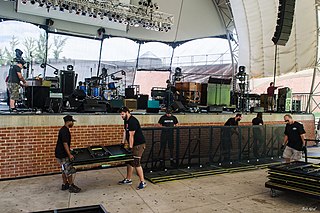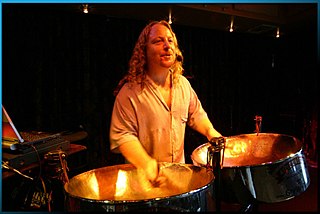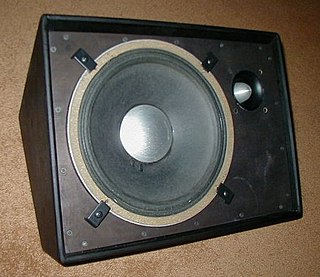
The road crew are the support personnel who travel with a band on tour, usually in sleeper buses, and handle every part of the concert productions except actually performing the music with the musicians. This catch-all term covers many people: tour managers, production managers, stage managers, front of house and monitor engineers, lighting directors, lighting designers, lighting techs, guitar techs, bass techs, drum techs, keyboard techs, pyrotechnicians, security/bodyguards, truck drivers, merchandise crew, and caterers, among others.

An instrument amplifier is an electronic device that converts the often barely audible or purely electronic signal of a musical instrument into a larger electronic signal to feed to a loudspeaker. An instrument amplifier is used with musical instruments such as an electric guitar, an electric bass, electric organ, electric piano, synthesizers and drum machine to convert the signal from the pickup or other sound source into an electronic signal that has enough power, due to being routed through a power amplifier, capable of driving one or more loudspeaker that can be heard by the performers and audience.

A rhythm section is a group of musicians within a music ensemble or band that provides the underlying rhythm, harmony and pulse of the accompaniment, providing a rhythmic and harmonic reference and "beat" for the rest of the band. The rhythm section is often contrasted with the roles of other musicians in the band, such as the lead guitarist or lead vocals whose primary job is to carry the melody.

Scooch is a British pop group, comprising performers Natalie Powers, Caroline Barnes, David Ducasse and Russ Spencer.

A rehearsal is an activity in the performing arts that occurs as preparation for a performance in music, theatre, dance and related arts, such as opera, musical theatre and film production. It is undertaken as a form of practising, to ensure that all details of the subsequent performance are adequately prepared and coordinated. The term rehearsal typically refers to ensemble activities undertaken by a group of people. For example, when a musician is preparing a piano concerto in their music studio, this is called practising, but when they practice it with an orchestra, this is called a rehearsal. The music rehearsal takes place in a music rehearsal space.

The Devils & Dust Tour was a 2005 concert tour featuring Bruce Springsteen performing alone on stage on a variety of instruments. It followed the release of his 2005 album Devils & Dust. The tour was named the Top Small Venue Tour of 2005 by the Billboard Touring Awards.

The Daydream World Tour was the second concert tour by American singer-songwriter Mariah Carey in support of her fifth studio album Daydream (1995). The tour lasted seven shows, starting on March 7, 1996, in Tokyo, Japan, and ending on June 23, 1996, in London, England.

A backing track is an audio recording on audiotape, CD or a digital recording medium or a MIDI recording of synthesized instruments, sometimes of purely rhythmic accompaniment, often of a rhythm section or other accompaniment parts that live musicians play along with or sing along to. Backing tracks enable singers and bands to add parts to their music which would be impractical or impossible to perform live, such as string section or choir parts which were recorded in the studio. A backing track can be used by a one person band to add any amount of bass, drums and keyboards to their live shows without the cost of hiring extra musicians. A small pop group or rock band can use backing tracks to add a string section, horn section, drumming or backing vocals to their live shows.
Mono's 1998 tour, promoting the album Formica Blues, was the only tour undertaken by the band, which formed in 1996 and broke up in the years following the tour.

Live sound mixing is the blending of multiple sound sources by an audio engineer using a mixing console or software. Sounds that are mixed include those from instruments and voices which are picked up by microphones and pre-recorded material, such as songs on CD or a digital audio player. Individual sources are typically equalised to adjust the bass and treble response and routed to effect processors to ultimately be amplified and reproduced via a loudspeaker system. The live sound engineer listens and balances the various audio sources in a way that best suits the needs of the event.
The Queen + Paul Rodgers Tour was the first world concert tour by Queen guitarist Brian May and drummer Roger Taylor, joined by singer Paul Rodgers under the moniker of Queen + Paul Rodgers. The tour was Queen's first since The Magic Tour in 1986, and the death of lead singer Freddie Mercury in November 1991. The band's drummer Roger Taylor commented; "We never thought we would tour again, Paul (Rodgers) came along by chance and we seemed to have a chemistry. Paul is just such a great singer. He's not trying to be Freddie." Bassist John Deacon also did not take part due to his retirement in 1997.

Vocal harmony is a style of vocal music in which a consonant note or notes are simultaneously sung as a main melody in a predominantly homophonic texture. Vocal harmonies are used in many subgenres of European art music, including Classical choral music and opera and in the popular styles from many Western cultures ranging from folk songs and musical theater pieces to rock ballads. In the simplest style of vocal harmony, the main vocal melody is supported by a single backup vocal line, either at a pitch which is above or below the main vocal line, often in thirds or sixths which fit in with the chord progression used in the song. In more complex vocal harmony arrangements, different backup singers may sing two or even three other notes at the same time as each of the main melody notes, mostly with a consonant, pleasing-sounding thirds, sixths, and fifths.
An offstage instrument or choir part in classical music is a sound effect used in orchestral and opera which is created by having one or more instrumentalists from a symphony orchestra or opera orchestra play a note, melody, or rhythm from behind the stage, or having a choir of singers sing a melody from behind the stage.
The In the Flesh Tour, also known as the Animals Tour, was a concert tour by the English rock band Pink Floyd in support of their 1977 album Animals. It was divided in two legs: one in Europe and another in North America. The tour featured large inflatable puppets, as well as a pyrotechnic "waterfall", and one of the biggest and most elaborate stages to date, including umbrella-like canopies that would rise from the stage to protect the band from the elements.

A stage monitor system is a set of performer-facing loudspeakers called monitor speakers, stage monitors, floor monitors, wedges, or foldbacks on stage during live music performances in which a sound reinforcement system is used to amplify a performance for the audience. The monitor system allows musicians to hear themselves and fellow band members clearly.

An audition is a sample performance by an actor, singer, musician, dancer or other performer. It typically involves the performer displaying their talent through a previously memorized and rehearsed solo piece or by performing a work or piece given to the performer at the audition or shortly before. In some cases, such as with a model or acrobat, the individual may be asked to demonstrate a range of professional skills. Actors may be asked to present a monologue. Singers will perform a song in a popular music context or an aria in a Classical context. A dancer will present a routine in a specific style, such as ballet, tap dance or hip-hop, or show his or her ability to quickly learn a choreographed dance piece.

This is a glossary of jazz and popular music terms that are likely to be encountered in printed popular music songbooks, fake books and vocal scores, big band scores, jazz, and rock concert reviews, and album liner notes. This glossary includes terms for musical instruments, playing or singing techniques, amplifiers, effects units, sound reinforcement equipment, and recording gear and techniques which are widely used in jazz and popular music. Most of the terms are in English, but in some cases, terms from other languages are encountered.

A rock band or pop band is a small musical ensemble that performs rock music, pop music, or a related genre. A four-piece band is the most common configuration in rock and pop music. In the early years, the configuration was typically two guitarists, a bassist, and a drummer. Another common formation is a vocalist who does not play an instrument, electric guitarist, bass guitarist, and a drummer. Instrumentally, these bands can be considered as trios. Sometimes, in addition to electric guitars, electric bass, and drums, also a keyboardist plays.
Miming in instrumental performance or finger-synching is the act of musicians pretending to play their instruments in a live show, audiovisual recording or broadcast. Miming in instrument playing is the musical instrument equivalent of lip-syncing in singing performances, the action of pretending to sing while a prerecorded track of the singing is sounding over a PA system or on a TV broadcast or in a movie. In some cases, instrumentalists will mime playing their instruments, but the singing will be live. In some cases, the instrumentalists are miming playing their instruments and the singers are lip-synching while a backing track plays. As with lip-synching, miming instrument playing has been criticized by some music industry professionals and it is a controversial practice.

Secret World Tour was a 1993–94 concert tour mounted by British singer-songwriter Peter Gabriel to promote his 1992 album Us. The stage show was designed by French-Canadian Robert Lepage, expressing the themes of tension and union between male and female forces, as represented by two stages linked by moving walkway. Three tour legs with elaborate staging were interspersed with two legs of much simpler WOMAD festival dates. Many of the same songs were performed by Gabriel, and he felt that all of his large-scale performances during these two years were part of the same tour. Secret World was Gabriel's first major solo outing since his tour of 1986–87 to support the album So. Afterward, he waited for almost a decade before embarking on the next tour, Growing Up, in 2002.
















